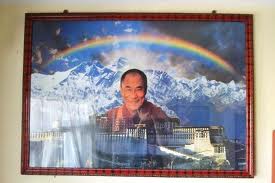Monks at the Gaden monastery in Tibet’s capital Lhasa were informed on June 28 that they can now display pictures of His Holiness the Dalai Lama. According to reports received in the exile community, the 17-year ban on portraits of the Tibetan spiritual leader had been lifted and the Chinese government was allowing the display of the Dalai Lama’s image in certain Tibetan areas, and allowing worship of him as a religious, but not political, leader. The monasteries are located in the regions of Amdo and Kham.
Beijing authorities have been careful not to give any written endorsements of their policy to the Tibetan monasteries. According to analysts, Chinese authorities are uncertain of the outcome or response to their new approach to the issue of the Dalai Lama’s image.
Soon after the news broke of this shift in Chinese policy, China’s State Administration for Religious Affairs denied any reversal of its policy regarding the Dalai Lama, saying there had been “no policy change.” The government maintained that China’s policy towards the Dalai Lama, considered by Beijing a “splittist,” was “consistent and clear”.

A large portrait of His Holiness the Dalai Lama and a huge Tibetan national flag were publicly displayed in Serthar County in Karze, eastern Tibet on October 1, 2011.
Photo: woeser.middlay-way.net
On June 28, Chinese authorities in Qinghai Province sent a text message to Tibetan residents with mobile phones to say that the regime’s policy towards the Dalai Lama and the display of his image has not changed. The statement said “[w]e clearly announce that there is no change in the policy of the CCP [Chinese Communist Party] and Government toward the 14th Dalai [sic]” and that rumours of change were “only exaggeration”, spread by those who “intend to ruin the development and security of the Tibetan area”. The statement was distributed by an SMS text message system used by the Propaganda Committee. It is not clear how many residents of the area received the message.
On July 18 China announced more stringent measures to crackdown on what it calls “illegal publications” and “reactionary promotional products”. China deems publications on the Dalai Lama, the exile Tibetan administration, the Tibetan freedom struggle and literature on human rights as “illegal” and “reactionary.”





 Print
Print Email
Email